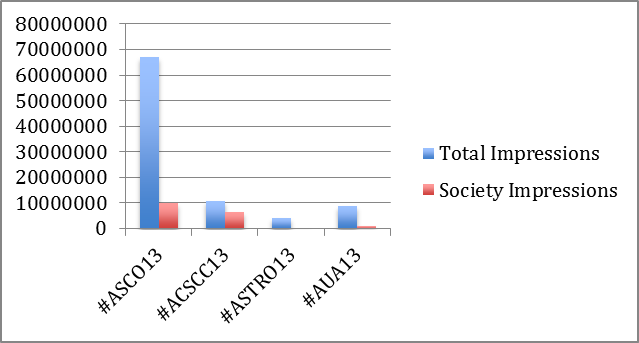It’s always busy when you attend a professional society annual meeting—attending academic sessions on new research, health policy, educational sessions, networking, catching up with friends, recruiting or job searches, and more. Increasingly, these interactions are being captured online.
Twitter is great at capturing some of these real-time interactions— so who is using it as a way to share his or her annual meeting experience?
I decided to pull free data from Symplur on four recent professional society meetings with submitted hashtags: American College of Surgeons (#ACSCC13); American Society of Clinical Oncology (#ASCO13); American Society for Radiation Oncology (#ASTRO13); and the American Urological Association (#AUA13). I did not filter through carefully to separate out possible other uses of these hashtags, so the results should be taken with a grain of salt. Because of chatter that often occurs before and after the meeting, I included one week before and two weeks after the meeting itself. Impressions are measured by the number of tweets multiplied by the number of followers of the person tweeting.
The results are very interesting:
 |
Online impressions, 1 week before until two weeks after the meeting |
#ASCO13 had dramatically more absolute activity than the other society meetings—over 67 million impressions. Also important is that the society itself took an active role with 490 tweets during that time period. As a result, it had 9.8 million impressions in less than four weeks—a lot of attention for ASCO!
Now ASCO is a very big meeting compared to ASTRO—I’ve never attended the other two meetings. But it has had a significant increase in Twitter use even from past research by Bob Miller. Part of it is the higher number of people using Twitter.
 |
Tweets and participants during the meeting |
For ASCO, these all represent significant increases from earlier research looking at 2010-2011 Twitter use. But from 2012, there was a 68% rise in the number of participants from 2,239 to 3,751. ASCO staff also got much more active—tweets about the meeting jumped to 490 from just 147 in 2012.
When you look at individual activity, the ACS and AUA tweeters were more active, averaging seven and eight tweets each, respectively. ASTRO was similar to ASCO at four versus five per tweeter.
Does that mean ASCO will influence cancer care more than the other meetings? Not necessarily. But some research suggesting tweet activity are linked to higher research article citations and downloaded preprints of scientific research. Twitter may be relevant to how effective professional societies are at sharing research and the organizational mission.
The combined effect of more participants, more activity, and more influence gave ASCO a major edge. But with wider adoption among annual meeting attendees, don’t be surprised if the other three organizations catch up.
More research is needed, and my datamining on Symplur was very broad and simplistic. But it’s a good way to start a conversation about the value of social media for physicians. What do you think about Twitter use at academic meetings?
NOTE: This blog was first published on Mayo Clinic’s Social Media Health Network.


Recent posts